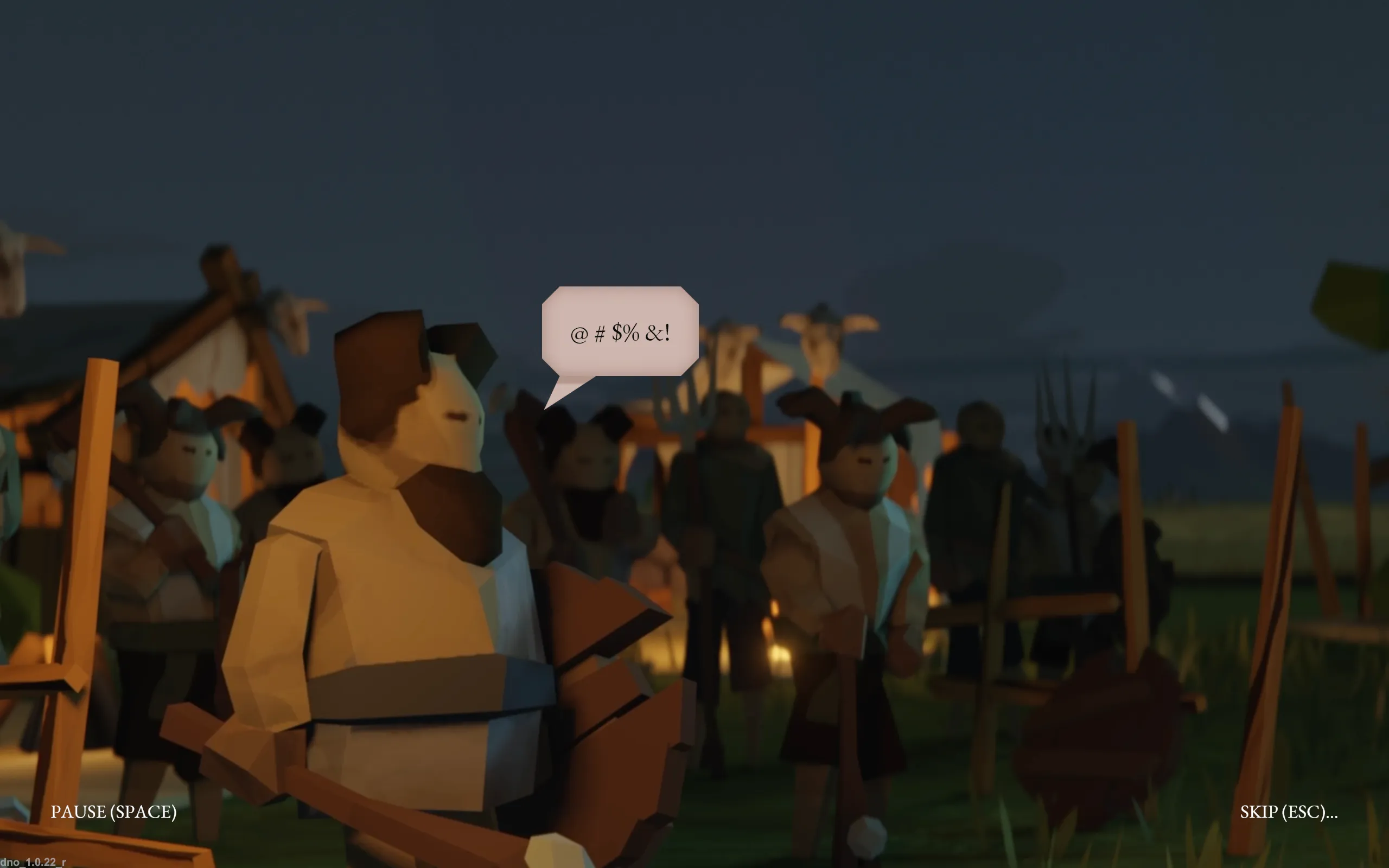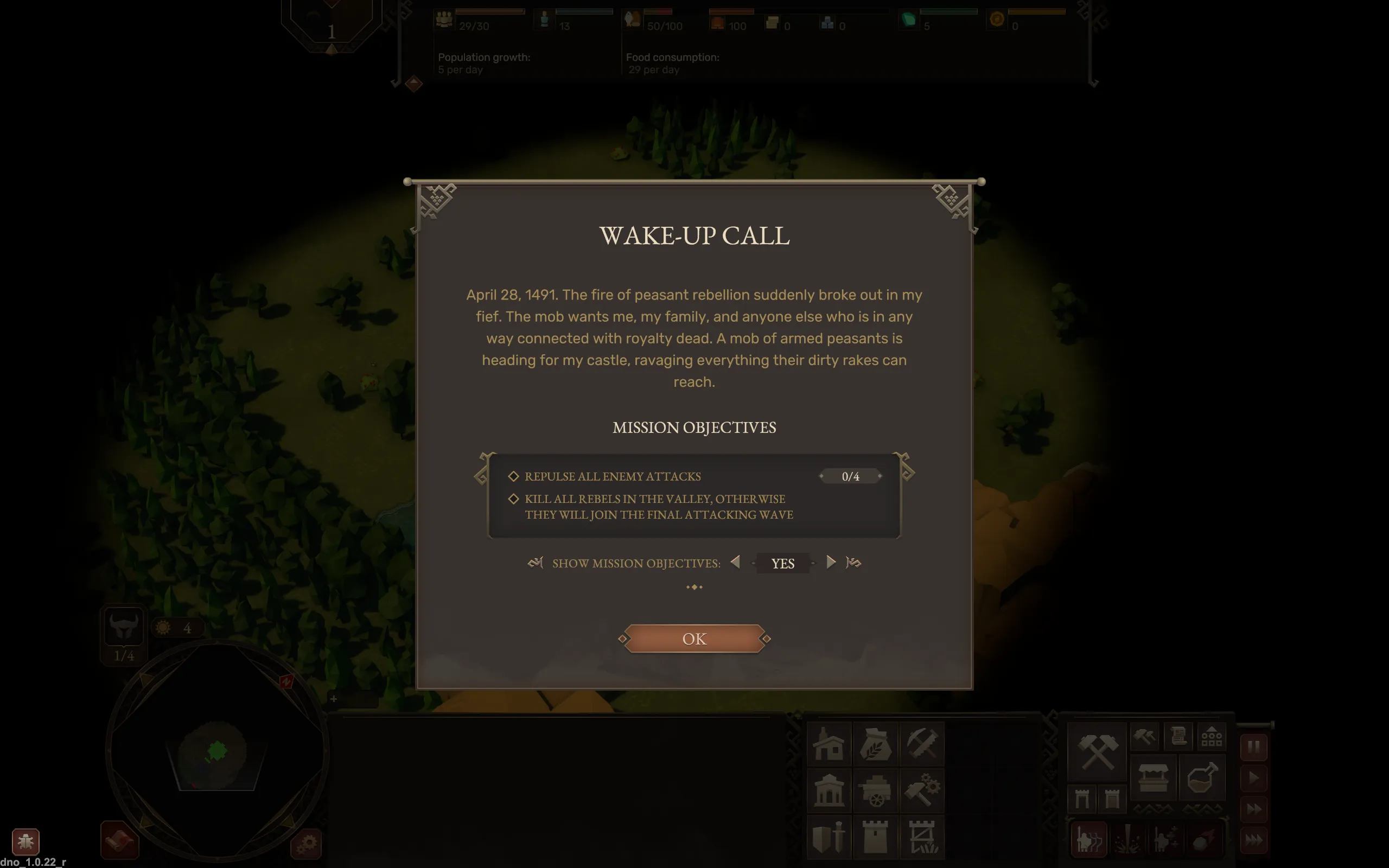Diplomacy is not an Option
In my Age of Empires review, I talked about growing up on RTSes. The quick-thinking, fast-paced world of armies, battles, and building quickly isn’t new to me. Still, when an RTS shows up on my list, I always have a moment of wondering what I’m going to be in for. Like all genres, RTSes can vary in quality, and there’s nothing quite so painful as a bad RTS.
Diplomacy is not an Option isn’t a bad RTS, per se. It’s just a flawed one in ways that really don’t work for me.
 You and me both, friend.
You and me both, friend.
Diplomacy is not an Option is a fantasy RTS. It follows the story of a nobleman who, when faced with a peasant revolt breaking down his gate, can choose to fend off the revolting peasantry, or join them. I, of course, chose to join the revolting peasants, but you can be a tyrant if you want, I suppose.
Much like most RTSes, Diplomacy is not an Option focuses on base building, with the player accruing resources, building structures, and fortifying their base as quickly and as thoroughly as possible. Diplomacy is not an Option focuses specifically on surviving massive waves of enemies, which informs how that base is built and structured.
 I chose to build walls because I'm good at this! :D
I chose to build walls because I'm good at this! :D
The idea of building a base to withstand hordes of enemies, reinforcing it, and stocking it with soldiers ready for battle is a good one. There’s a lot of mileage in the idea, and a lot of fun to be had. Diplomacy is not an Option, however, takes several steps that undermine the fundamental fun of this idea and make it more of a slog.
Take, for example, the idea of waves themselves. Each wave, the player gets a warning of an upcoming wave, with an indication of where it will be coming from, and how much time is left before the wave arrives. This warning allowed me to rearrange my base, moving my heavy artillery where it needed to go, and building extra fortifications on whichever side needed them. The consequence of this, however, was that I was then over-prepared for whatever arrived. Hordes of enemies would throw themselves at my wall, and would die there, piled in rotten mounds, serving as a warning to any who would later try the same. Even when I raised the difficulty, the fundamental structure of warning me what was coming and where meant it was difficult not to win.
This was, of course, not helped by the terrible AI of the individual units. In the time between waves, I would send my soldiers out on raids, marauding the countryside, stealing resources, and massacring anyone who objected. The time between raids is voluminous and unskippable, so I had plenty of time to raid, then return my soldiers back to my town to make bored faces at the revolting peasantry. Each time, though, I would have at least one soldier who couldn’t figure out the concept of walking through a gate, and would need to be manually guided in lest he be devoured by whatever mob next appeared at my walls. Similarly, when the mob did arrive and break a hole in my wall, rather than swarming inside and ravaging my town, they instead focused on continuing to tear down the wall, allowing me to finish them off without incident.
Having each individual member of a mob behave rationally is difficult to program. Having the mob as a unit prioritise the goal of destroying me rather than my walls, however, seems like it ought to have been a priority. Instead, I could just sit back, taking pot shots while soldiers picked away at my endless rings of walls.
 I feel like if it's 1491 and you're a noble, you probably deserve whatever's coming.
I feel like if it's 1491 and you're a noble, you probably deserve whatever's coming.
The seemingly endless time Diplomacy is not an Option presents the player with is made more endless by its coupling with an odd idea of space. The map the player has to play with is, of course, limited in its size. Scattered throughout it are enemy encampments waited to be cleared out by bored soldiers. However, some encampments are large and require more advanced and dedicated soldiering, and thus can’t be cleared without either throwing waves of soldiers at them or by waiting until there is sufficiently advanced technology to make progress.
All this is, of course, perfectly fine in theory. In practice, however, it falters. The buildings in Diplomacy is not an Option have large footprints relative to the map, and the requirement that they be accessible on at least one side means that there needs to be a careful consideration of space and how best to use it. With certain buildings like the farm, however, there needs to be a massive amount of space set aside, with a huge percentage of the area within the city walls being dedicated to it.
This meant that, in my playthrough, I kept expanding and expanding, building expensive series of consecutive walls. I tried to expand to gain the resources I needed for my soldiers, only to find that my walls were butting into precisely the enemy encampments I was gathering the resources to clear. There is a fundamental lack of space on the map that limits how the player can solve the problems around them. When paired with the eternity between enemy waves, the inability to build or make meaningful forward progress leads to a lot of game time spent just browsing the board, waiting for something to happen.
The game, in essence, is just kind of boring.
I’m sure, if I played through the entire game, I’d find a variety of scenarios putting different window dressing on the same ideas. The enemies might get shinier, more colourful, or more numerous. The walls might get higher, and the war machines fancier. To get there, though, I have to slog through hour after painful hour, waiting for enemies to chew on my walls while I take potshots, and eying the list of other things I could be doing with my time.
It’s not worth it. This game is not interesting enough in what it’s doing to be worth it. It’s just dull.
Developer: Door 407
Genre: Real-time strategy
Year: 2024
Country: Russia
Language: English
Play Time: 30-40 hours
Playthrough: https://youtu.be/9AQk2QbI_NY
